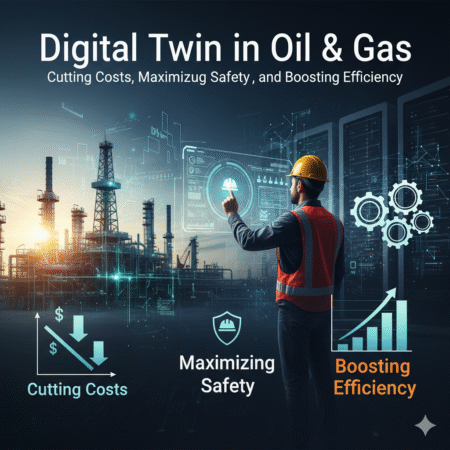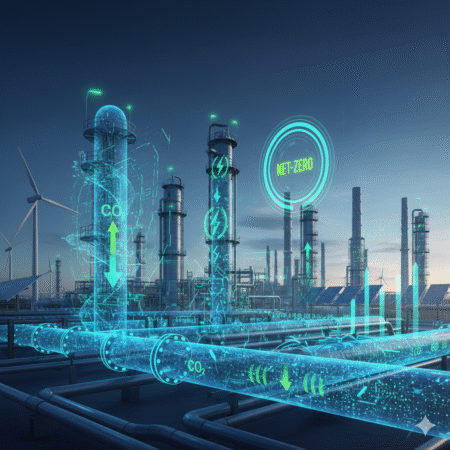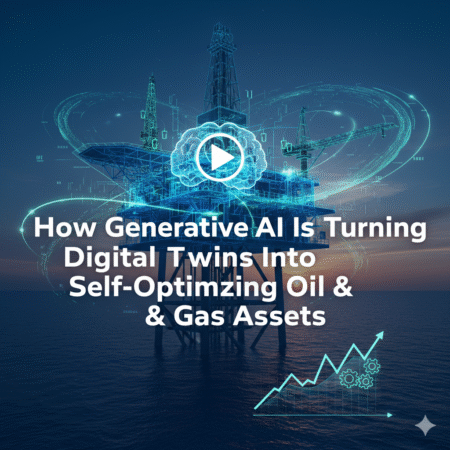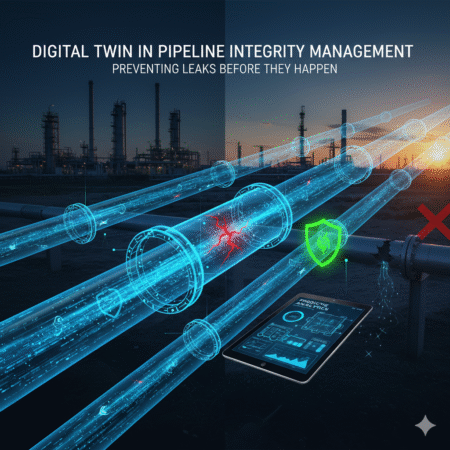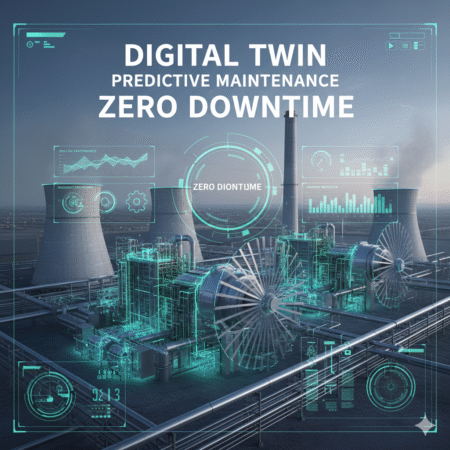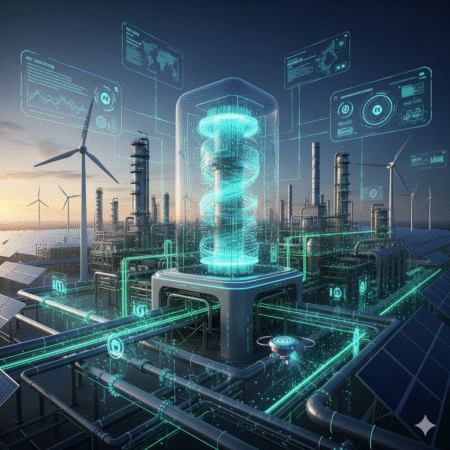
- Introduction: Why Oil & Gas Needs Digital Twin Now
- What is a Digital Twin in Oil & Gas? (Simplified Definition)
- Key Benefits of Digital Twin in Oil & Gas
- Real-World Use Cases of Digital Twin in Oil & Gas
- ROI of Digital Twin in Oil & Gas: Numbers That Matter
- Challenges in Digital Twin Adoption
- The Future of Digital Twin in Oil & Gas (2025–2030)
- How to Start Your Digital Twin Journey (Step-by-Step Guide)
- Conclusion & Call to Action
Introduction: Why Oil & Gas Needs Digital Twin Now
Picture this: an offshore oil platform in the North Sea suddenly experiences an unplanned shutdown. Every hour that production halts, the operator loses up to $1 million-not counting penalties for missed delivery contracts and the cascading effect on global energy supply. For decades, downtime like this was treated as a cost of doing business. But in 2025, with razor-thin margins, volatile oil prices, and mounting ESG pressure, those “accepted losses” are no longer acceptable.
This is where digital twin technology enters the picture-not as a buzzword, but as a lifeline. Think of it as a living, breathing replica of your physical asset-a turbine, a subsea pipeline, or even an entire refinery-fed in real time by IoT sensors, SCADA data, and AI-driven analytics. It’s not just a digital model; it’s a control tower that tells you what’s happening now, what’s likely to happen next, and what you should do about it.
The numbers tell a compelling story. According to MarketsandMarkets, the global digital twin market in oil & gas is projected to reach $14.2 billion by 2030, growing at over 25% CAGR. That’s not hype-it’s fueled by real-world pain points:
- Unplanned downtime costing the industry billions each year.
- Aging infrastructure in mature basins like the Gulf of Mexico and North Sea.
- Workforce transformation, where skilled engineers are retiring faster than replacements can be trained.
- And, of course, ESG and Net Zero mandates, forcing operators to maximize efficiency while cutting emissions.
In other words, oil & gas companies are at an inflection point. They either embrace digitalization-or risk becoming the next case study of decline.
But here’s the kicker: adopting digital twin is no longer just about cutting costs. It’s about survival in an industry where reputational, regulatory, and safety stakes are higher than ever. One cyber breach at a refinery or one catastrophic equipment failure offshore can trigger not only financial losses but also environmental disasters and shareholder lawsuits.
That’s why in 2025, conversations in boardrooms have shifted. Executives aren’t asking “Should we explore digital twin?” anymore. They’re asking, “How fast can we deploy it-and where should we start?”
This article will take you deep into that journey. We’ll break down what digital twin really means for oil & gas, explore real-world use cases from offshore platforms to LNG plants, crunch the ROI numbers, and outline the step-by-step roadmap to adoption. By the end, you’ll see why digital twin is quickly becoming the most important lever for cost reduction, safety, and long-term competitiveness in the sector.
What is a Digital Twin in Oil & Gas? (Simplified Definition)
Imagine you’re drilling a new offshore well. You’ve got hundreds of sensors capturing vibration, temperature, and pressure data every second. But raw numbers on a SCADA screen don’t tell the full story-they’re like having GPS coordinates without the map. This is where a digital twin comes in.
At its core, a digital twin is a virtual mirror of your physical asset-whether it’s a compressor, subsea pipeline, drilling rig, or even an entire refinery. Unlike traditional models, it’s not static. It’s alive. It continuously updates in real time as new data streams in from IoT sensors, SCADA systems, ERP platforms, and even drone or satellite inspections.
The best analogy? Think of it like Google Maps for your assets. Google Maps doesn’t just show you where roads are-it shows real-time traffic, predicts travel time, and even suggests alternate routes when there’s a jam. A digital twin does the same thing for oil & gas infrastructure: it tells you the current health of your assets, predicts potential problems, and recommends optimal operating conditions.
Now, let’s clear up a common confusion. Many executives think, “We already have simulations and SCADA dashboards. Isn’t that the same thing?” The answer is no. Traditional simulations are static “what if” models. SCADA is a snapshot of current operations. A digital twin combines both-a live, learning system that evolves with every data point.
To make it simple, let’s break down the maturity levels of digital twin adoption in oil & gas:
- Descriptive Twin – Basic visualization: “Here’s what’s happening now.”
- Predictive Twin – Uses AI/ML to forecast failures: “Here’s what might happen.”
- Prescriptive Twin – Suggests actions: “Here’s what you should do.”
- Autonomous Twin – Self-learning system that can adjust parameters or shut down equipment automatically to prevent disaster.
Most oil & gas companies today are somewhere between descriptive and predictive. The holy grail is the autonomous twin-imagine a refinery that can self-correct energy inefficiencies or a pipeline that can reroute flow automatically in case of a leak risk.
And here’s the kicker: the industry is already moving fast. According to Deloitte, nearly 75% of major oil & gas operators have piloted digital twin initiatives, but less than 20% have fully scaled them. Why? Because while the technology is ready, integration with legacy infrastructure and organizational buy-in remain the big hurdles.
So, when you hear “digital twin,” don’t think of it as another IT buzzword. Think of it as your 24/7 digital co-pilot-one that doesn’t just monitor your assets but actively helps you run safer, leaner, and smarter operations.
Key Benefits of Digital Twin in Oil & Gas
Picture this: An offshore platform in the North Sea suddenly faces a compressor failure. Every hour of downtime costs the operator nearly $1.5 million in lost production. In the old days, engineers would scramble, fly in specialists, and pray the problem didn’t cascade into a safety hazard. Today, with a digital twin, that nightmare can often be avoided entirely.
That’s the real power of this technology-it doesn’t just collect data, it turns operations from reactive firefighting into proactive value creation. Here’s how:
Cost Reduction
Oil & gas is capital-intensive, and unplanned downtime is brutal. According to McKinsey, predictive maintenance powered by digital twins can cut maintenance costs by up to 20% and reduce unplanned outages by up to 50%. Instead of changing parts on a fixed schedule (which might be too early or too late), the twin tells you the exact moment a turbine blade, pump seal, or drilling motor needs service. That means fewer wasted dollars and fewer shutdowns.
Safety & Risk Mitigation
In this industry, a single accident can cost lives, not just money. Digital twins allow operators to simulate hazardous scenarios-gas leaks, blowouts, fires-without ever putting people or assets in danger. For example, Equinor has used digital twin simulations in offshore operations to model emergency evacuations and equipment failures, giving crews a clear playbook before disaster strikes. It’s like having a virtual fire drill, running 24/7.
Efficiency Gains
Every barrel of oil and cubic foot of gas must be produced as efficiently as possible. Digital twins optimize energy use, adjust operating conditions, and identify bottlenecks in real time. A refinery in Texas used a process twin to reduce energy consumption by 8%, translating into millions in annual savings-not to mention lower emissions.
Compliance & ESG Alignment
Regulators are getting tougher on emissions, and investors are demanding ESG accountability. A digital twin helps operators monitor carbon intensity, detect methane leaks, and ensure compliance with environmental standards. Think of it as an automated ESG assistant-tracking, reporting, and optimizing sustainability metrics in real time. In fact, BP recently reported that using digital twin technology in refining helped them achieve measurable reductions in CO₂ per barrel processed.
Here’s the bottom line: Digital twin technology isn’t just a “nice-to-have.” It’s becoming the core operating system for modern oil & gas-delivering measurable ROI, saving lives, and securing license to operate in an ESG-driven world.
Companies that adopt now will run leaner, safer, and greener. Those who delay? They’ll be stuck with higher OPEX, greater risks, and regulators breathing down their neck.
Real-World Use Cases of Digital Twin in Oil & Gas
Let’s be real-oil & gas isn’t forgiving. A single equipment failure offshore can cost millions of dollars per day in downtime. On top of that, safety risks and environmental fines are always looming. This is exactly where digital twin moves from “buzzword” to “lifesaver.” Let’s break down how industry leaders are already applying it.
Read More: Digital Twin and AI Synergy in Plant Operations
Offshore Platform Integrity Monitoring
Imagine an offshore rig in the North Sea facing extreme weather. Traditionally, engineers would need scheduled inspections-often risky, costly, and reactive. With a digital twin, the platform’s structural integrity can be monitored in real-time. Stress points on topsides, subsea structures, and risers are simulated digitally, allowing engineers to predict failures before they happen.
Result? Operators cut inspection costs by up to 30%, while reducing the risk of sending crews into hazardous conditions.
Pipeline Leak Detection & Flow Assurance
Pipeline leaks aren’t just expensive-they’re PR nightmares. A mid-size leak can spill thousands of barrels, leading to regulatory penalties in the hundreds of millions. Digital twin models combined with IoT sensors simulate pressure, temperature, and flow dynamics across thousands of miles of pipeline.
For example, BP deployed digital twin technology across its pipelines, enabling faster detection of anomalies. This means leaks can be spotted within minutes instead of hours, saving millions in avoided fines and cleanup costs.
Refinery Digital Twin for Energy Efficiency
Refineries are energy monsters. Even a 1% improvement in efficiency can save tens of millions annually. A digital twin of a refinery doesn’t just mirror physical assets-it models the entire process flow: crude distillation, cracking units, heat exchangers.
Shell reported up to 8–10% energy savings by implementing digital twin models across its refining operations. That’s not just cost cutting-it’s progress toward ESG goals and reduced carbon footprint.
Drilling Operations Optimization
Drilling is one of the most capital-intensive parts of oil & gas. A single offshore well can cost $50–100 million. Any non-productive time (NPT) is a financial hit. Digital twin models of drilling equipment and downhole conditions allow operators to simulate “what-if” scenarios, reducing the risk of blowouts, stuck pipes, or unexpected formation changes.
Equinor has used digital twin drilling models in the North Sea, cutting drilling time by nearly 20%, saving tens of millions per project.
LNG Plant Predictive Maintenance
LNG plants rely heavily on massive compressors and turbines. If one fails, production halts. A digital twin continuously monitors vibration, temperature, and pressure data, predicting failures weeks in advance. Instead of waiting for a breakdown, operators can plan a maintenance window at optimal times, avoiding costly shutdowns.
Case in point: An LNG operator in Qatar achieved 15% reduction in OPEX within the first year of deploying a predictive digital twin model.
The takeaway? Digital twin in oil & gas isn’t just a shiny new tool-it’s already saving billions, reducing environmental risks, and keeping workers safer. And the best part: these aren’t hypothetical use cases-they’re happening now in real-world operations.
ROI of Digital Twin in Oil & Gas: Numbers That Matter
Here’s the truth: every oil & gas executive loves innovation… until they see the price tag. Digital twin projects often raise eyebrows because the initial investment isn’t small-sensors, integration, software licenses, and training. But here’s the catch: when you run the numbers, the return on investment (ROI) is insanely compelling.
Downtime Avoidance = Millions Saved
Let’s start with downtime. An offshore platform can lose $1–3 million per day when production stops. With digital twin predictive models, operators can spot issues in compressors, pumps, or turbines before they spiral into failures.
For example, a North Sea operator reported cutting non-productive time (NPT) by 15%, which translated into $20 million in avoided losses annually. Imagine paying $5–10 million upfront for a digital twin rollout, and recouping it in less than a year. That’s not innovation-it’s common sense.
OPEX Savings in the Double Digits
Most refineries and LNG plants spend a fortune on operations and maintenance. Studies show digital twin adoption can reduce OPEX by 10–15%, thanks to optimized maintenance schedules, reduced spare parts inventory, and smarter energy use.
Example: A Middle East LNG operator invested ~$12 million in digital twin implementation. Within 18 months, they saved over $18 million in reduced fuel gas consumption and predictive maintenance benefits. That’s a 50% ROI in less than two years.
Safety and Risk Reduction = Avoided Fines & Lives Saved
It’s hard to put a price tag on safety, but regulators certainly try. A single environmental spill can cost hundreds of millions in fines and cleanup. Digital twin models allow companies to simulate leak scenarios, pressure surges, or equipment blowouts before they happen.
Not only does this reduce risk, but it also slashes insurance premiums. Some insurers are already offering reduced premiums (up to 8–10%) for operators leveraging advanced digital twin safety models.
ESG & Compliance = Strategic ROI
Here’s the hidden ROI: carbon compliance. With governments tightening emission standards in the US, UK, and Canada, failure to meet ESG requirements means not just fines, but also lost access to capital markets. Digital twins optimize energy use, cut flaring, and improve reporting transparency-making companies more attractive to investors.
Quick Snapshot: Cost vs Benefit
| Investment Area | Typical Cost | Annual Benefit | ROI Timeline |
|---|---|---|---|
| Offshore digital twin (platform) | $5–10M | $15–20M (downtime avoided) | < 1 year |
| Refinery energy twin | $10–15M | $20–30M (OPEX saving + carbon compliance) | 1–2 years |
| LNG predictive twin | $8–12M | $12–18M (maintenance + fuel savings) | 18–24 months |
Bottom Line
Digital twin isn’t just an engineering upgrade-it’s a CFO’s dream. Numbers don’t lie: faster payback, double-digit OPEX reduction, and risk mitigation that can literally save lives. The real question for decision makers isn’t “Can we afford to invest in digital twin?” but rather “Can we afford NOT to?”
Challenges in Digital Twin Adoption
Here’s the uncomfortable truth: while the promise of digital twin sounds like a golden ticket-lower OPEX, higher safety, better compliance-the road to adoption is anything but smooth. Many oil & gas companies jump in with big ambitions, only to hit roadblocks that stall projects or kill them entirely. Let’s break down the most common challenges (and the lessons learned).
Integration Nightmares: When Old Meets New
Most oil & gas facilities run on legacy systems-DCS, SCADA, ERP, CMMS-that were never designed to “talk” to each other, let alone feed a real-time digital twin. The result? Painful integration.
A Gulf refinery tried rolling out a digital twin for its crude distillation unit but underestimated the IT/OT integration complexity. Weeks turned into months, costs ballooned, and the project eventually went on “pause.” Lesson? Without a solid integration strategy, your digital twin risks becoming a very expensive dashboard.
Garbage In, Garbage Out: Data Quality Issues
A digital twin is only as good as the data feeding it. But let’s be real-many plants have incomplete sensor coverage, poor calibration, or missing historical data.
In one failed case, a refinery in Asia tried modeling pump efficiency, but inconsistent sensor data made predictions unreliable. Operators stopped trusting the twin, and adoption collapsed. The takeaway? Data governance and sensor reliability must come first.
Cybersecurity: A New Attack Surface
Connecting IT and OT to enable a digital twin sounds great-until hackers find the weak spots. Oil & gas is already a top target for cyberattacks, and digital twin platforms introduce new vulnerabilities.
According to IBM’s 2024 Threat Intelligence Report, the average cost of an energy sector breach hit $4.7 million. Now imagine a cyber incident that compromises both your production data and your safety simulations. This is why cybersecurity has to be baked into every twin deployment-not bolted on later.
High Initial CAPEX: The CFO’s Biggest Objection
Yes, digital twins pay off quickly (as we saw in ROI), but let’s face it: the upfront cost is significant. Hardware sensors, IoT gateways, data lakes, software licenses, and training can easily run into the tens of millions.
For companies under pressure from volatile oil prices, justifying that spend isn’t easy-especially when returns aren’t visible until 12–24 months down the line. That’s why starting small with a pilot project is often the smartest move.
People and Culture: The Silent Killer
Here’s one challenge nobody likes to admit: resistance to change. Engineers might see digital twins as “management buzzwords.” Operators may resist because they fear being replaced. Without buy-in from both sides, even the most advanced digital twin ends up underused.
A European operator learned this the hard way when they launched a refinery-wide twin, only to find that engineers continued using their spreadsheets and manual logs. Adoption rates tanked-not because of technology, but because of mindset.
The Bottom Line
Digital twin adoption isn’t plug-and-play. Integration hurdles, bad data, cybersecurity risks, high CAPEX, and human resistance all stand in the way. But here’s the kicker: every challenge has a solution-if companies prepare upfront. The winners in 2025 and beyond won’t be those who avoid challenges, but those who confront and overcome them faster than their competitors.
The Future of Digital Twin in Oil & Gas (2025–2030)
Imagine this: it’s 2030, and an offshore platform in the North Sea detects early signs of a potential compressor failure. But instead of shutting down operations or waiting for human intervention, the digital twin automatically triggers a drone inspection, adjusts system loads in real-time, and schedules predictive maintenance with zero downtime. That’s not science fiction-it’s where oil & gas is headed.
The next five years will define how digital twins move from “experimental projects” into core infrastructure for every operator. Let’s break down the trends that will reshape the industry.
AI + Digital Twin = Autonomous Oilfield
Today, digital twins can describe and predict. By 2030, they’ll prescribe and even act. Thanks to AI integration, the shift is toward autonomous operations.
Instead of engineers manually analyzing reports, machine learning models will continuously optimize drilling parameters, predict flow assurance issues, and recommend safety measures in real-time. McKinsey estimates that AI-powered digital twins could deliver 15–20% additional productivity gains on top of today’s efficiency.
IoT & Edge Computing: Real-Time, Zero-Latency Decisions
Latency kills in oil & gas. Whether it’s detecting a pipeline leak or preventing a blowout, milliseconds matter. That’s where edge computing comes in.
Instead of sending all data to the cloud, digital twins will process critical insights directly at the asset level-on the platform, at the refinery, or inside the pipeline station. By 2027, Gartner predicts that over 70% of industrial IoT data will be processed at the edge.
This means faster response times, reduced bandwidth costs, and smarter decision-making where it matters most.
Sustainability-Driven: From Oilfields to Greenfields
Digital twins won’t just help pump oil faster-they’ll become central to decarbonization strategies. Expect tight integration with carbon capture systems, flare monitoring, and renewable power balancing.
For instance, an LNG plant in 2028 may run its operations not only to maximize efficiency but also to optimize carbon intensity per ton of LNG exported. Digital twins will become the nerve center of net-zero commitments.
Vision: Zero-Incident, Zero-Emission Smart Refinery
The holy grail is a self-regulating, self-healing refinery. Think predictive maintenance that prevents accidents before they occur, AI-driven energy management that cuts carbon output, and automated compliance reporting that satisfies regulators instantly.
Equinor and Shell are already experimenting with this “digital-first refinery” concept. By 2030, what looks ambitious today will likely become industry standard-because the cost of not adopting will be too high.
The Bottom Line
The future of digital twins in oil & gas isn’t just about efficiency. It’s about reinventing how the industry operates in a volatile, decarbonizing world. Operators that embrace AI, IoT, edge computing, and sustainability-driven twins will lead. Those that hesitate risk falling behind.
The choice is simple: in 2030, will your refinery be the one running itself-or struggling to catch up?
How to Start Your Digital Twin Journey (Step-by-Step Guide)
Imagine this: you’re the operations manager of an offshore oil platform. Every hour of unplanned downtime costs your company between $300,000 and $1 million. The pressure is insane. You’ve heard about digital twin technology saving giants like Shell and BP millions, but the question buzzing in your head is: “Where do I even start?”
That’s the dilemma many oil & gas leaders face in 2025. Everyone knows the potential – reduced OPEX, improved safety, faster ESG compliance – but the path to adoption often feels like navigating a maze. The good news? You don’t need to leap into a full-scale digital twin transformation on day one. Instead, treat it like a well-planned drilling campaign: start small, test, learn, then scale.
Here’s a step-by-step roadmap to kick off your digital twin journey without drowning in complexity:
Step 1: Identify High-Value Assets
Don’t try to “twin” your entire operation on day one. Focus on assets with the highest downtime cost or safety risk – compressors, turbines, or subsea pipelines. For example, one North Sea operator started with just one gas compressor and saved $2.5 million in unplanned downtime in the first year.
Step 2: Define Clear Business Outcomes
Ask: What problem are we solving? It could be reducing unplanned downtime, cutting emissions, or extending asset life. Without clear outcomes, your digital twin risks becoming a shiny tech toy with no ROI. Tie each use case directly to OPEX savings or safety KPIs.
Step 3: Start Small with a Pilot
Run a pilot project on a single site or asset. This minimizes risk and helps build internal buy-in. A pilot in a refinery’s heat exchanger system, for example, revealed inefficiencies that improved energy efficiency by 8%, enough to justify scaling up.
Step 4: Ensure Integration from Day One
A digital twin isn’t a stand-alone system. It must integrate with your DCS, SCADA, ERP, and CMMS. Poor integration is the #1 reason digital twin projects fail. Invest in data governance and real-time connectivity – think of it as laying pipelines for information flow.
Step 5: Scale & Expand
Once the pilot proves value, expand to other assets and sites. Build a long-term roadmap – predictive maintenance today, ESG-driven optimization tomorrow, and by 2030, maybe even an autonomous digital oilfield. The trick? Scale smartly, not hastily.
Quick Checklist: Do’s & Don’ts
- Do: Start with measurable business outcomes.
- Do: Involve both engineers and IT teams.
- Don’t: Treat digital twin as an “IT project” – it’s an operations project powered by IT.
- Don’t: Underestimate cybersecurity – every new sensor is a potential entry point.
At the end of the day, adopting digital twin isn’t about chasing the latest buzzword. It’s about building a future-proof operation where downtime, accidents, and inefficiency no longer control your bottom line. Companies that take the first step today will be the ones writing the rules of tomorrow’s oil & gas industry.
And the real question for you is: will you lead, or will you wait until your competitors force your hand?
Conclusion & Call to Action
Picture this: it’s 3 a.m. on an offshore platform in the Gulf of Mexico. Suddenly, a compressor trips. Within minutes, production halts. Every passing hour bleeds $500,000 in lost revenue, not to mention safety risks for the crew. Now imagine if a digital twin had been in place – it could’ve predicted the failure days earlier, scheduled a controlled shutdown, and saved millions. That’s not science fiction. That’s the reality companies like BP and Equinor are already living in.
The oil & gas industry in 2025 doesn’t have the luxury of “wait and see.” Pressures from volatile energy prices, ESG commitments, and rising safety expectations mean decision-makers must act today. Digital twin isn’t just another buzzword; it’s a competitive moat. It separates those who merely survive from those who thrive.
Let’s break it down:
- Cost savings: Up to 10–15% OPEX reduction is achievable through predictive maintenance and asset optimization.
- Safety gains: Simulations of gas leaks, blowouts, or fires reduce human exposure to high-risk scenarios.
- Efficiency boost: Digital twins unlock new benchmarks in production efficiency and energy optimization.
- ESG compliance: With mounting pressure from regulators and investors, digital twin technology provides measurable progress toward net-zero goals.
But here’s the kicker: while the benefits are massive, the adoption gap is real. A McKinsey survey revealed that less than 20% of oil & gas operators have scaled digital twins across multiple assets. Translation? The window of opportunity is still wide open. Those who move first will capture outsized benefits – not just in savings, but in market reputation as safer, greener, and smarter operators.
So, what should you do right now?
- Stop overthinking. You don’t need to twin your entire operation from day one.
- Start small. Pick one high-value asset, run a pilot, prove ROI.
- Build momentum. Scale from pilot to portfolio, and use the savings to fund the next phase.
Here’s the reality: every day you delay is another day competitors get ahead. The companies who adopt digital twins today will define the oilfields and refineries of tomorrow – safer, leaner, and more sustainable.
👉 If you’re a decision-maker in oil & gas, the next move is yours. Will you wait for another costly shutdown to push you into action, or will you lead the transformation before your rivals do?
🔔 Subscribe to EngineerDaily for more hands-on insights on AI, Digital Twin, and Industrial Tech – because the future of energy isn’t just digital, it’s twin-powered.
